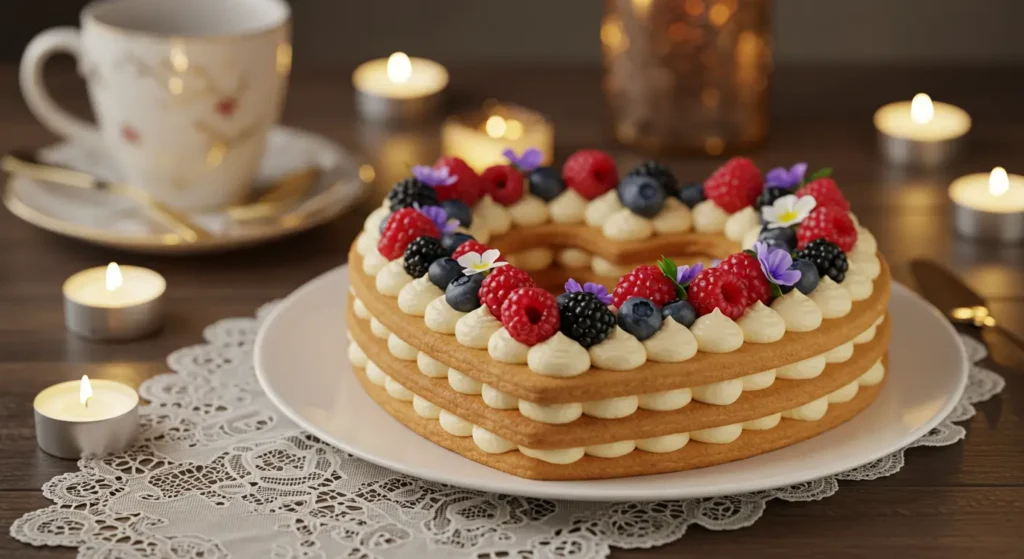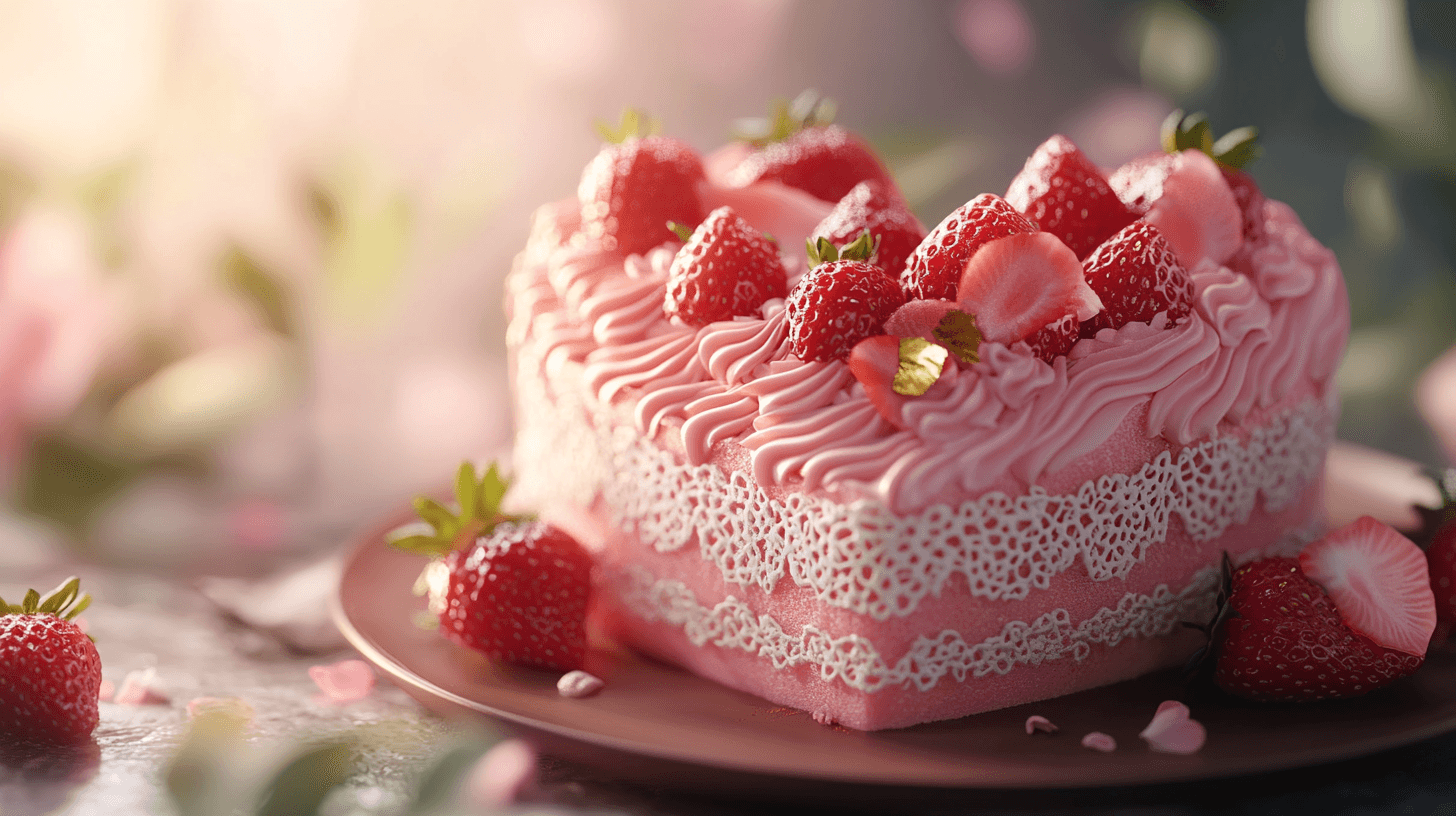Heart cakes are a delightful combination of flavor, beauty, and sentiment. Perfect for Valentine’s Day, anniversaries, birthdays, or any special occasion, these cakes are more than just desserts—they’re edible expressions of love and creativity. In this heart cake recipe, we’ll show you how to bake and decorate the perfect heart-shaped cake. Whether you’re an experienced baker or trying your hand at something new, this guide will help you create a stunning centerpiece for any celebration.
Table of contents
What is a Heart Cake Recipe?
A heart cake recipe is a detailed, step-by-step guide to creating a cake in the shape of a heart. This design isn’t just for romantic occasions—it’s versatile enough to suit a variety of events, including birthday parties, weddings, and even baby showers. A properly executed heart cake recipe balances flavor, texture, and presentation, creating a dessert that both looks stunning and tastes delicious.
The iconic heart shape is a powerful symbol of love and emotion, making it a popular choice for sentimental celebrations. While you can purchase a pre-made heart cake, crafting one yourself adds a personal touch to the event. For inspiration, consider exploring this guide to the history and meaning of heart shapes. Additionally, you can find pre-made heart cake molds and other baking essentials at stores like Wilton.
Popularity and Occasions for Heart Cakes
Heart cakes are beloved worldwide for their charm, versatility, and symbolic meaning. These cakes have become a staple for celebrations that focus on love, joy, and togetherness. Moreover, their appeal lies in their ability to be both a visual masterpiece and a delicious treat.
Occasions That Call for a Heart Cake Recipe
- Valentine’s Day:
Valentine’s Day wouldn’t be complete without a heart-shaped dessert. These cakes, often decorated with red frosting, roses, or even chocolate ganache, symbolize affection and thoughtfulness. If you’re looking for creative Valentine’s ideas, Good Housekeeping offers more suggestions to make your day special. - Anniversaries:
A heart cake recipe adds a romantic touch to anniversary celebrations. Whether you’re commemorating your first year or your 50th, a beautifully designed cake reflects enduring love. - Birthdays:
In addition, heart cakes can add a fun twist to birthdays with vibrant, colorful designs. For more decoration ideas tailored to birthdays, Taste of Home has an array of tips and themes for special occasions.
Evolution of the Heart Cake Recipe
History of Heart-Shaped Cakes
The tradition of sculpted cakes dates back to the Victorian era, a time when grand gestures of love were highly valued. Bakers started experimenting with shaped cakes, with the heart becoming one of the most iconic designs. Early recipes focused on simplicity, often featuring basic flavors like vanilla or sponge cake with minimal decoration.
As baking techniques advanced in the 20th century, the heart cake recipe began to take on more intricate forms. For example, the introduction of fondant icing and buttercream piping allowed bakers to elevate their designs, turning heart cakes into true works of art. If you’d like to learn more about the evolution of cake designs, explore this timeline of baking innovations.
Ingredients for the Perfect Heart Cake Recipe
Basic Ingredients for the Sponge
For a moist, fluffy heart cake recipe, you’ll need:
- All-purpose flour or cake flour for the base.
- Granulated sugar (or brown sugar for added depth).
- Butter or vegetable oil for richness.
- Eggs to provide structure and stability.
- Baking powder or baking soda for leavening.
- Milk or buttermilk to enhance moisture.
- Vanilla extract for a classic aroma (or substitute with almond or lemon extract for variety).

For tips on substitutions or ingredient variations, you can reference this ingredient conversion guide from AllRecipes.
How to Make a Heart Cake Recipe
Step-by-Step Instructions for Baking
- Preheat Your Oven:
- Set your oven to 350°F (175°C).
- Grease your heart-shaped pan generously and line it with parchment paper for easy removal.
- Prepare the Batter:
- Cream the butter and sugar: Use a mixer to blend until light and fluffy.
- Add the eggs one at a time, mixing well after each addition.
- Sift the flour, baking powder, and a pinch of salt into a separate bowl.
- Gradually add the dry ingredients to the butter mixture, alternating with milk or buttermilk.
- Finally, mix in vanilla extract or your preferred flavoring.
- Pour and Bake:
- Pour the batter into your prepared pan. Tap the pan lightly on the counter to release air bubbles.
- Bake for 25–30 minutes. Test doneness by inserting a toothpick into the center; if it comes out clean, the cake is ready.
For additional baking tips and troubleshooting, see Betty Crocker’s baking advice section.
Decoration Ideas for a Heart Cake Recipe
Fondant vs. Buttercream: Which to Choose?
- Fondant:
- Provides a smooth, polished finish ideal for professional-looking cakes.
- Works well for creating intricate details like ribbons, bows, or embossed patterns.
- Buttercream:
- Easier to apply and more forgiving for beginners.
- Allows for textured designs like rosettes or ruffles.
Decoration Ideas for a Heart Cake Recipe
Creative Decoration Ideas
- Edible Flowers: Use fresh edible blooms like pansies, roses, or marigolds for a natural, elegant touch.
- Chocolate Accents: Add shaved chocolate, chocolate curls, or molded shapes for a decadent finish.
- Color Themes: Match the cake’s frosting and decorations to the event’s theme, such as red and gold for Valentine’s Day or pastel shades for spring celebrations.
- Sprinkles and Glitter: Add a playful element with colorful sprinkles or edible glitter for sparkle.
Healthy Alternatives for Heart Cakes
Not all cakes need to be indulgent calorie bombs. By tweaking the ingredients, you can create a heart cake recipe that is both delicious and health-conscious. Whether you’re catering to dietary restrictions or simply looking for lighter options, these substitutions will help you craft a healthier heart cake.
Gluten-Free Heart Cakes
For guests with gluten sensitivities, replace all-purpose flour with gluten-free alternatives such as:
- Almond flour: Adds a nutty flavor and soft texture.
- Rice flour: Works well for a light and fluffy sponge.
- Gluten-free flour blends: Pre-mixed options designed for baking.
Vegan Heart Cakes
For vegan-friendly cakes, substitute animal-based ingredients with plant-based alternatives:
- Egg replacements: Use flaxseed meal or unsweetened applesauce.
- Non-dairy milk: Replace regular milk with almond, soy, or oat milk.
FAQs About Heart Cake Recipes
What’s the best way to store a heart cake?
Store your cake in an airtight container at room temperature for up to two days. For cakes with cream-based frosting, refrigerate it and let it come to room temperature before serving.
Can I make a heart cake in advance?
Yes, you can bake the sponge a day before. It’s best to decorate the cake on the day of the event to ensure the frosting remains fresh and vibrant.
What size heart cake should I choose?
An 8-inch heart cake serves about 8–10 people. For larger gatherings, consider scaling up or making multiple layers.
Conclusion
A heart cake recipe is more than just a dessert—it’s a heartfelt gesture that adds a personal touch to any celebration. Whether for Valentine’s Day, anniversaries, or birthdays, this cake is sure to impress. Following this guide ensures your heart cake recipe will be a delicious centerpiece for any occasion.

